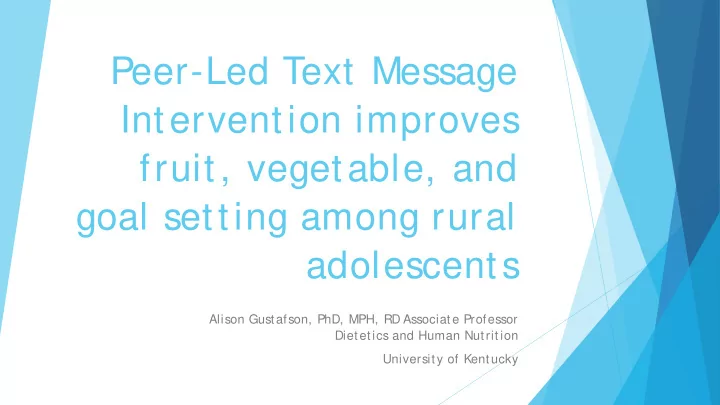

Peer-Led Text Message Intervention improves fruit, vegetable, and goal setting among rural adolescents Alison Gustafson, PhD, MPH, RD Associate Professor Dietetics and Human Nutrition University of Kentucky
Background Rural and minority adolescents have higher rates of obesity and consume fewer fruits and vegetables relative to their urban counterparts[1, 2]. Additionally, rural and minority adolescents are at greater risk for cardiovascular disease and associated co-morbidities relative to their urban minority counterparts[3]. A host of factors related to geographic isolation, socio-economic status, and lack of access to affordable healthy foods all contribute to the growing prevalence of obesity and poor dietary outcomes[1, 4]. University of Kentucky Dietetics and Human Nutrition
Why Text messaging? In recent years, there has been increasing proliferation of interventions utilizing text-messaging and web based applications (“apps”) as tools to encourage and promote healthy behaviors. Such technology- based interventions have been successful for tobacco cessation, reducing alcohol abuse[12-14], and weight loss among adolescents[15]. Specifically related to dietary intake, several weight loss interventions have utilized mobile applications to deliver targeted messages about weight loss behaviors and text messages containing tailored dietary feedback[16]. Overall, these strategies are effective at producing weight loss among adults and adolescents[17]. Yet, there are no interventions aimed at providing affective messages targeting intake of fruit, vegetable, and low-calorie beverages, specifically among rural dwelling and minority adolescents[18, 19]. Moreover, there are limited interventions explicitly utilizing theory-based design in the text message content[19, 20]. University of Kentucky Dietetics and Human Nutrition
Research AIMS The overall aims of this paper are to report the intervention effect on: 1) fruit, vegetable, and sugar-sweetened beverage intake compared to controls; 2) food shopping habits; 3) home availability of fruits, vegetables, healthy and less healthy snacks, and sugar-sweetened beverages; and 4) key theoretical constructs that were imbedded within the messages (self- efficacy and goal setting). University of Kentucky Dietetics and Human Nutrition
Intervention Details – Methods Conducted in Kentucky and North Carolina University of Kentucky Dietetics and Human Nutrition
Intervention Components Undergraduate students in DHN were trained and sent affective messages over the course of 8-weeks “ How do you feel when you can choose to eat fruit? ” Messages were sent two times per week focused on improving fruit, vegetable, and low-calorie beverage intake Feedback was then tailored to what the adolescent responded with after the initial message University of Kentucky Dietetics and Human Nutrition
An Example of the undergrad: adolescent exchange Group Me is a free app that was used. This can be used with large groups but for confidentiality there was j ust a 1:1 exchange University of Kentucky Dietetics and Human Nutrition
Results Demographics Baseline Characteristics of Intervention and Control participants (n=411) Intervention (n=277) Control (n=134) Age (mean) 15 (.07) 15 (.10) Gender Female 61% 67% Male 38% 30% Other (Male to Female; Female to Male; Other) Race White 72% 55% p=.01 Other (African American/hispanic) 28% 45% p=.01 Dietary Intake and Body Mass Index Fruit and Vegetable Servings (mean and SE) 3.83 (.24) 5.56 (.54) p=.01 Sugar-sweetened beverage calories (mean and SE) 439 (31) 470 (54) Sugar-sweetened beverage grams (mean and SE) 1112 (79) 1200 (140) BMI z-score percentile (mean and SE) .76 (.02) .72 (.02) Food Shopping Practices Buy fruit and vegetables (mean times per week purchased) 16 (.99) 13 (.92) Buy Fast-food (mean times per week) 31 (.99) 27 (1.26) Buy Healthy Snack foods (mean times per week) 8.74 (.54) 6.39 (.59) Buy Less Healthy Snack 15.88 (.84) 13.58 (1.05) Buy SSB 10.33 (.48) 9.95 (.68) Buy water or no calorie beverages 5.38 (.30) 5.22 (.40) University of Kentucky Dietetics and Human Nutrition
Results –AIM 1 (Primary Outcome – F/ V) Dietary Intake and BMI Change within intervention participants Change within control participants Difference between inte Fruit and Vegetable servings .71 (-.02, 1.45) -1.52 (-2.48, -.56)* 1.28 (1.11, 1.48)* SSB Calories -61 (-125, 80)* -39 (-149, 71) -39 (-164, 85) Total Beverage Calories -26 (-139, 87) -118 (-320, 83) 14.99 (-186, 216) University of Kentucky Dietetics and Human Nutrition
Results –AIM 2 Food Shopping practices Fruit and Vegetables purchases over 7 days 2.55 (.69, 4.42)* 1.39 (-.65, 3.44) 1.07 (.94, 1.22) Less healthy snack purchases over 7 days .82 (-.88, 2.53) -.18 (-2.13, 1.75) 1.06 (.85, 1.33) Healthy snack purchases over 7 days 1.81 (.68, 2.94)* 1.87 (.54, 3.20)* 1.02 (.84, 1.23) SSB beverage purchases over 7 days .26 (-.71, 1.24) -.25 (-1.64, 1.14) 1.02 (.85, 1.21) Water or no calorie beverage purchases .87 (.18, 1.56)* .36 (-.58, 1.31) 1.03 (.88, 1.21) University of Kentucky Dietetics and Human Nutrition
Results –AIM 3 Home Availability (Percent Change Reported) Fruit and Vegetables p=.3 p=.02 p=.03 Never <1% 7% Sometimes 4% 6% Always 5% -13% Vegetables served at dinner p=.08 p=.2 p=.03 Never -2% -12% Sometimes 7% 11% Always -5% -3% Junk Food p=.008 p=.68 p=.01 Never 8% 1% Sometimes -4% 3% Always -5% -4% University of Kentucky Dietetics and Human Nutrition
Results- AIM 4 Table 3. Intervention Effect on Constructs inbedd Odds Ratio 95% CI Self-Efficacy Fruit .93 [.73, 1.29] Vegetable 1.59 [1.19, 2.13]* Healthy Snacks .72 [.48, 1.09] Goal Setting Fruit 1.52 [1.18, 1.95]* Vegetabke 1.75 [1.19, 2.58]* Sugar-Free Beverage 1.94 [1.18, 3.27]* University of Kentucky Dietetics and Human Nutrition
Conclusion A mentor-led text message intervention with affective messaging improves fruit and vegetable intake These programs can be disseminated across health insurance companies, other universities, and health departments as a way to improve dietary intake Future directions – an R01 application is under review to test this approach with a 8*2 = 16 week program on long-term outcomes and cost-effectiveness for broader dissemination University of Kentucky Dietetics and Human Nutrition
Acknowledgements Cooperative Extension All High S chool staff, principals, teachers All the students Undergraduate students Co-Investigators – S tephanie Jilcott Pitts, Janet Mullins University of Kentucky Dietetics and Human Nutrition
Funding US DA –Afri Childhood Obesity 2016-69001-24915 University of Kentucky Dietetics and Human Nutrition
Recommend
More recommend